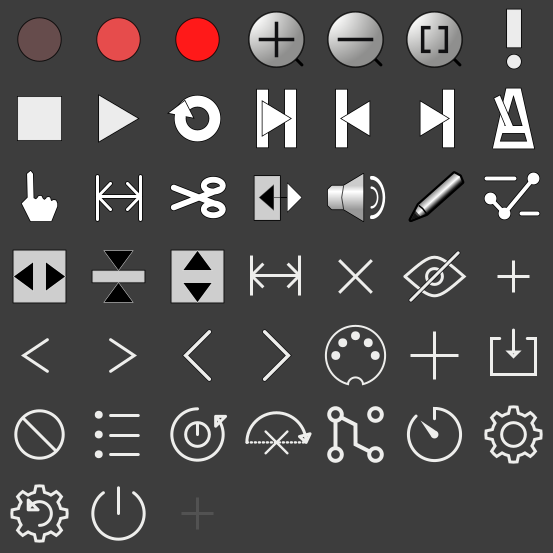Hello all,
I’ve been working on some software for use with Mixbus and a multi-touch display. The working title is “ShaleCrow” (as in, “not a slate raven”).
I started by buying an Acer T272HUL 27-inch multi-touch screen; it’s HD 1440P (2560 * 1440 pixels) and was cheap ($250 used). It as an HDMI video input, and USB touch output. It can be used with the cross-platform UPDD device driver to send OSC messages to a program running on the computer, just like TouchOSC and similar programs on tablets.
Like TouchOSC, the ShaleCrow translator uses a “map” of the screen in which rectangular regions are defined by their location and size, and by the OSC messages that they send to Mixbus. ShaleCrow then listens to the messages coming in from the touchscreen, translates them using the map, and sends the corresponding OSC messages to the DAW. It’s fully multi-touch, meaning that you can drag several sliders at once, limited only by the number of fingers you have.
ShaleCrow also defines a control panel with buttons at the bottom of the screen; this includes transport controls, a jog wheel, and a host of other useful operations (see Figure 1 below).
There are options (controlled by the monitor screen in Figure 4) to display the region map overlaid on the Mixbus screen; examples of this are shown in Figures 2 and 3. There are mapping options for “large faders,” whereby the entire region at the bottom of the channel strip is used for the fader, and “details” mode, wherein all of the controls (pan, trim, mute/solo, compressor, etc.) are mapped.
Since many of the controls are too small to use with your fingers, I made large pop-up details screens for the strip controls (the top-most section of the strip), the EQ section, and the sends. Figure 5 below shows an example of the EQ pop-up.
I made a quick video demo of the working prototype for your comments; here it is:
https://vimeo.com/553581133
Notes
For the most part, ShaleCrow would also work with Ardour, though of course the screen layout is different; it does have a more complete OSC implementation than Mixbus.
The UPDD device driver supports many other touchscreen models, and supports multiple touchscreens on one computer, so it’d be possible to have both main DAW views responding to touch commands.
I’m looking for collaborators who can contribute design ideas and/or coding help to this project. I haven’t decided whether to make it open-source, closed-source freeware, or a cheap commercial product.
ShaleCrow is written in C++ and uses the JUCE and CSL frameworks, so it ought to work on Macs, PCs and Linux hosts.
Comments/questions are solicited…
Issues
As of now, the DAW screen layout is stored in an XML file that’s set up for each session (a terrible idea). It would be much better to either (a) “read” the screen (via computer vision software like OpenCV) to discover where the inputs and bus strips are, or (b) (DO THIS) augment Mixbus to respond to an OSC query with a list of geometry data, like the x-coordinate for the left edge of each channel, and the status of its strip (EQ and Sends expanded or collapsed). With MB32C, the channel widths and heights of the elements are fixed.
In theory (according to the Ardour manual) it’s possible to ask the DAW for the list of a channel’s plug-ins and their controls, and even for a list of the sends from a channel, but this appears not to be implemented in Mixbus. To make the pop-up editors work, I’d need to be able to get the send levels, EQ settings and other parameters from the DAW.
This isn’t rocket science, but I’m hoping for a partner in the project. I have the Ardour and Mixbus sources, and have most of the required libraries installed.
Figures
Figure 1. Mixbus DAW mixer screen with the ShaleCrow control panel visible at the bottom.
http://fastlabinc.com/screen-w-control-panel.jpg
Figure 2. Mixbus DAW mixer screen including the map overlay with rectangular regions mapped to OSC messages. This map uses large areas for the faders.
http://fastlabinc.com/screen-w-big-faders-map.jpg
Figure 3. Mixbus DAW mixer screen including the map overlay. This map uses shows the details for the controls for the channel and compressor.
http://fastlabinc.com/screen-w-detail-map.jpg
Figure 4. ShaleCrow monitor view showing its controls and log of OSC messages sent to the DAW (dragging 3 faders).
http://fastlabinc.com/monitor2.jpg
Figure 5. EQ detail panel.
http://fastlabinc.com/eq-details.jpg
Stephen Travis Pope
Santa Barbara, California, USA
See also https://forum.harrisonconsoles.com/thread-10174-post-56710.html
